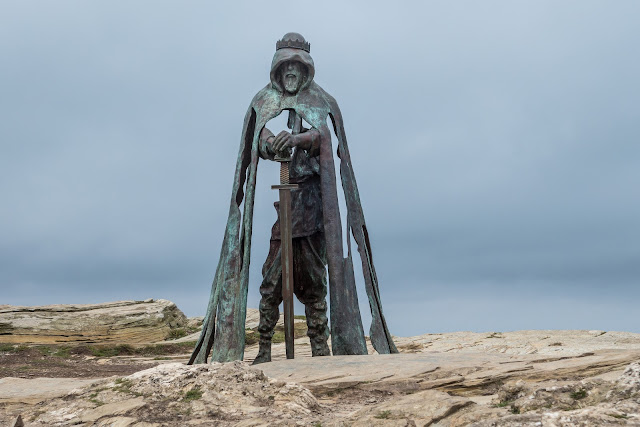Tintagel and Boscastle
One of the reasons we found accommodation in this area of North Cornwall, was the proximity of Tintagel Castle. Many great images have been taken off the area and many legends abound, so a visit was definitely for today. The many legends are centered around the mythical King Arthur, and I, like most boys, was introduced to him at an early age.
History and legend are inseparable at Tintagel. During the so-called Dark Ages (about the 5th to the 7th centuries AD) it was an important stronghold, and probably a residence of rulers of Cornwall. Many fragments of luxury pottery imported from the Mediterranean were left behind by those who lived here.
Today, the mystical tale of King Arthur is one of the great themes of British literature. But is there any truth behind the myth and why has it become so influential throughout the centuries?
The King Arthur that we know today is a collection of different legends, written by different authors, at different times. They are all united by the common theme that King Arthur was a fifth century British general who fought against Anglo-Saxon tribes and ensured that Britain remained a paradise of the West. The first mention of King Arthur is in the History of the Britons, penned in 830, and attributed to an author called Nennius.
He writes: Then in those days Arthur fought against them with the kings of the Britons, but he was commander in those battles.
A more elaborate tale of King Arthur came about in the 11th century, when Geoffrey of Monmouth published his book The History of the Kings of Britain. Arthur’s entire life is outlined for the first time in this work, right from his birth at Tintagel, to his death, and the legendary figures of Guinevere and Merlin are introduced. This book had a tremendous impact at the time. To this day, approximately 200 manuscripts remain in existence.
Then, with the marriage of Henry II of England to Eleanor of Aquitaine, the stories of Arthur began to bloom in the courts of France and the legend took on romantic and spiritual tones. It was within this context that the mysterious Holy Grail first appears in the work of French court writer Chretien de Troyes.
However, despite the entrenchment of Arthur within Celtic folklore, evidence of his actual existence is slim. In the histories of the time, there is no mention of an Arthur.
The consensus amongst most historians is that Arthur probably did exist, either as an individual or a composite of several individuals. Since many of the Dark Age heroes were real men upon whom mythical talent and position were often thrust by storytellers, there is a strong possibility that Arthur was a Dark Age warrior of the Celts from which the rest of the mythological superstructure was formed.
So, on to some images I took on our visit to Tintagel. Some of the ruins showing the precarious situation the castle occupied. Shame it is now only a ruin as it would have looked spectacular, I am sure.
There is a small bridge that has to be crossed to get from the land part of the castle to the rocky headland on which most of the history of Tintagel is found. At some point, there was a complete link between the two, but it has crumbled into the sea.
Merlin`s cave on the foreshore. Well, good for tourism!!
Some of the rugged coastline nearby.
In the town of Tintagel is this lovely old Post Office building. This 14th C medieval longhouse is a most delightful small buildings. The ancient undulating roof and massive chimney stack lend character to a fascinating building. The central hall is open to the great oak trusses and slates of the roof. A pleasing collection of country furniture, fine needlework samplers and a charming garden all add interest. During Victorian times one room was used as the letter-receiving office for the village and so the house became known as the Old Post Office.
The Victorian Post Box.
Then on to the picturesque fishing village of Boscastle with its medieval past and distinctive natural harbour and one of Cornwall’s most romantic places. It is a village steeped in history, associated with authors and artists who have been inspired by its remoteness and rugged beauty. Boscastle was once a favourite haunt of author,Thomas Hardy, and the setting for one of his novels, A Pair of Blue Eyes. It was here that he met his wife, Emma. In fact, the restoration of nearby St Juliot Church was worked upon by Hardy when he was still a practising architect.
Looking back toward the village from near the harbour entrance.
…. then looking seaward from near the same point.
The River Valency as it runs through the lower part of the village.
Some of the village house set just back from the river.
On 16 August 2004 an estimated 440 million gallons of water swept through the picturesque West Country town and led to the bursting of banks and the convergence of three rivers.
A total of 58 properties were flooded while four others were completely destroyed.
Around 100 people had to be plucked to safety by emergency teams, after mounting their roofs to escape the rising waters.
The town suffered millions of pounds worth of damage but as residents will also say of that day – it was astounding that nobody died.
http://www.bbc.co.uk/news/uk-england-cornwall-28523053 for more details of the devastation of 2004 when heavy localised rainfall – 89 mm of rain - fell in an hour.
Following the devastation, 4.5 million pounds was spent locally on flood defences. A new Boscastle bridge with a new storm water culvert was built as part of the flood measures.
















Comments